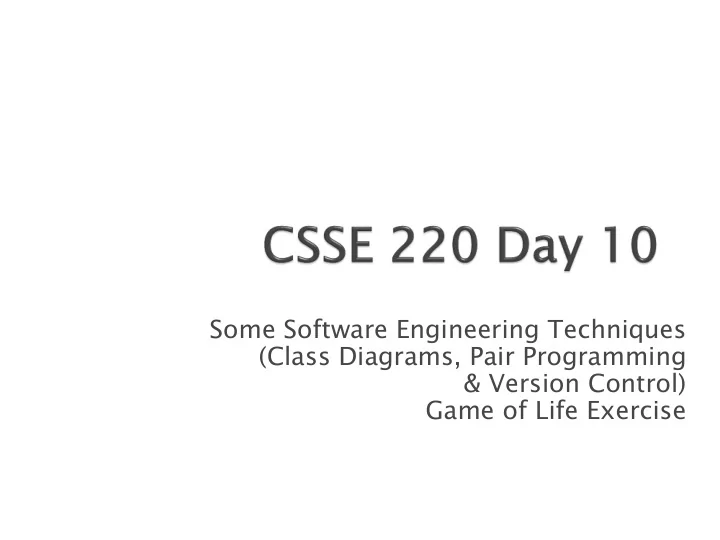

Some Software Engineering Techniques (Class Diagrams, Pair Programming & Version Control) Game of Life Exercise
Hint: software is the part of a computer system that is suppose to change! Take 15 seconds and think about it Turn to neighbor and discuss what you think for a minute Let’s talk? Iterative Waterfall Incremental Spiral Extreme Programming
Starting with Abstract Requirements, successively Elaborate and Refine them into specifications, models, and more concrete implementation A Software Process organizes the life cycle activities related to the creation, delivery, and maintenance/evolution of software systems Q1, 2
Class Diagramming Pair programming Team version control Brief mention of Regression Testing
public class Register { private ProductCatalog catalog; private Sale currentSale; ProductCatalog public Register(ProductCatalog pc) {...} ... catalog public void endSale() {...} public void enterItem(ItemID id, int qty) {...} getProductDesc(...) 1 public void makeNewSale() {...} public void makePayment(Money cashTendered) {...} } Sale Register isComplete : Boolean time : DateTime ... currentSale becomeComplete() endSale() 1 makeLineItem(...) enterItem(id: ItemID, qty : Integer) makePayment(...) makeNewSale() getTotal() makePayment(cashTendered : Money)
Class name Fields String Shows the: data : char[] ◦ Attributes ibutes (data, called field lds boolean contains (String s) in Java) and ◦ Oper eratio ations boolean endsWith (String suffix) (functions, called int indexOf (String s) metho thods ds in Java) of the objects of a class int length () Does not show the String replace (String target, implementation String replace) Is not necessarily String substring (int begin, int end) complete String toLowerCase () Methods String objects are immut utable le – if the method produces a String, the method returns that String rather than mutating (changing) the implicit argument Q3
Class Name Task: Make Class diagrams for the Fields Censor and Methods CensorTest classes from Word Games
Censor CensorTest characterToCensor : char censorEvery_e: Censor censorEvery_a: Censor setup () String transform (String stringToTransform) testAllCensorCharacters () testNoCensorCharacters () testCensoringAn_a () testUpperAndLowerCase () testSpecialCharacters () testAstrisks () testEmptyString () testLongString ()
Two programmers work side-by-side at a computer, continuously collaborating on the same design, algorithm, code, and/or test Enable the pair to produce higher quality code than that produced by the sum of their individual efforts Let’s watch a video… Q4
Working in pairs on a single computer ◦ The driver , uses the keyboard, talks/thinks out- loud ◦ The navigator , watches, thinks, comments, and takes notes ◦ Person who really understands should start by navigating For hard (or new) problems, this technique ◦ Reduces number of errors ◦ Saves time in the long run Q5
Pair-Pressure ◦ Keep each other on task and focused ◦ Don’t want to let partner down Pair-Think ◦ Distributed cognition: Shared goals and plans Bring different prior experiences to the task Must negotiate a common shared of action Pair-Relaying ◦ Each, in turn, contributes to the best of their knowledge and ability ◦ Then, sit back and think while their partner fights on Q6 Abstracted from: Robert Kessler and Laurie Williams
Pair-Reviews ◦ Continuous design and code reviews ◦ Improved defect removal efficiency (more eyes to identify errors) ◦ Removes programmers distaste for reviews (more fun) Debug by describing ◦ Tell it to the “Rosie in the Room” Pair-Learning ◦ Continuous reviews learn from partners ◦ Apprenticeship ◦ Defect prevention always more efficient than defect removal Q7 Abstracted from: Robert Kessler and Laurie Williams
Expert paired with an Expert Expert paired with a Novice Novices paired together Professional Driver Problem Culture Source: Robert Kessler and Laurie Williams
Take 15 seconds and think about it Turn to neighbor and discuss what you think for a minute and list a few examples Let’s talk?
Why? Again, software is suppose to change … Different releases of a product Variations for different platforms Hardware and software Versions within a development cycle Test release with debugging code Alpha, beta of final release Each time you edit a program Q8
You are in the middle Time of a project with three developers Releases 1.1a named a, b, and c. 1.2 1.1 1.1b 1.1c
Time First public release Releases of the hot new product 1.3 1.2 1.4 1.0 bugfix
Versi rsion on control rol tracks cks multipl iple e ve versi rsions ons ◦ Enables old versions to be recovered ◦ Allows multiple versions to exist simultaneously Alwa ways ys: ◦ Update ate befor ore e working ◦ Update ate again ain before committing ◦ Comm mmit it often ten and with good messages Communic unicate ate with teammates so you don’t edit the same code simultaneously ◦ Pair programming ameliorates this issue Q9
Update and Check Out Commit often! Update Edit Commit Update
Take 15 seconds and think about it Turn to neighbor and discuss what you think for a minute Let’s talk?
Keep and run old test cases Create test cases for new bugs ◦ Like antibodies, to keep a bug from coming back Remember: ◦ You can right-click the project in Eclipse to run all the unit tests
Go to SVN repository view at bottom of workbench ◦ Window show view Other SVN SVN Repositories Right click in SVN View, then choose New SVN Repository Location ◦ http://svn.csse.rose-hulman.edu/repos/csse220- 201420- ”your_team_repository”
A new cell is born on an 1. empty square if it has Cell exactly 3 neighbor cells A cell dies of 2. overcrowding if it is x surrounded by 4 or more neighbor cells A cells dies of 3. Neighbors loneliness if it has just 0 or 1 neighbor cells Developed by John Conway, 1970
Work with your partner on the GameOfLife project ◦ Get help as needed ◦ The TODOs are numbered – do them in the indicated order. ◦ Follow llow the practi actices ces of pair ir programm ogrammin ing! g! Don’t do any of the work without your partner!
Recommend
More recommend